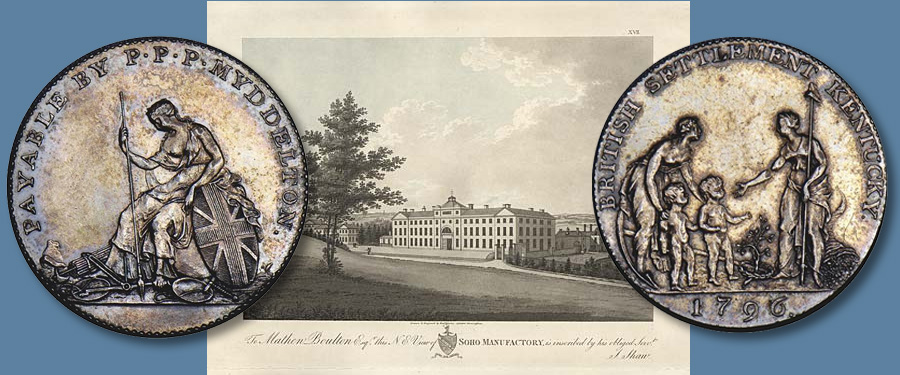
This story of one of my favorite tokens is excerpted from my 2002 More Adventures With Rare Coins, a book that showcased 50 of my favorite numismatic items. For more information, you can read The 100 Greatest American Medals and Tokens, written by Katherine Jaeger and myself, available from numismatic booksellers.
A Planned Settlement in Kentucky
In 1796 in England, Philip Parry Price, either surnamed Myddelton or from Myddelton, planned a real estate promotion whereby British citizens were to purchase tracts of land in Kentucky. To further this ambition, he commissioned the Soho Mint, a private enterprise operated by Matthew Boulton and James Watt in Birmingham, to create an appropriate token or medalet. Most likely, these pieces were produced primarily for numismatists, rather than prospective customers for land. Today, several dozen examples exist in silver (primarily) and copper, all with Proof finish.
The obverse is inscribed BRITISH SETTLEMENT KENTUCKY and illustrates Hope (representing Britain) presenting two of her children to the goddess Liberty who welcomes them with an outstretched arm, with a cornucopia of plenty behind her, this representing the bounty of America.
The reverse shows the goddess Britannia, dejected and defeated, possibly an allegory to the loss of her citizens or, reaching back further in history, the British losing the Revolutionary War (the latter the suggestion in Walter Breen’s Complete Encyclopedia of U.S. and Colonial Coins).
From an era in which tokens and medals often carried subtle as well as obvious messages, this particular piece ranks high in numismatic interest today. And, it has been thus for a long time. In his 1875 book, The Early Coins of America, Sylvester S. Crosby paid this piece the ultimate compliment: “In beauty of design and execution, the tokens are unsurpassed by any piece issued for American circulation.”
Diesinker Küchler
The dies were cut by Konrad Heinrich Küchler (usually given as Conrad H. Küchler) a gifted artist who also prepared the three different Washington Seasons medal motifs about the same time. Striking was accomplished at the Soho Mint, Birmingham, England.
Küchler was born in Flanders. It is likely that he was a diecutter in several German cities circa 1763-1775, his locations including Darmstadt, Mannheim, and Frankfurt-am-Main. He seems to have traveled widely in his work, including to Italy, France, and England. By the early 1790s he was in the employ of the Soho Mint, where he remained for a long time. While there he made dies for many coins and medals of England, including certain of the illustrious copper issues of 1797-1806. Dies were also cut for coins and medals relating to Russia, Portugal, Ireland, and Denmark.
The Soho Manufactory
Begun in 1759, the Soho Manufactory, as it was called, was well known by the time of Küchler’s arrival. The facility was situated on Hockley Brook, a convenient source for power until it dried up. James Watt, maker of steam engines, came to the rescue and set up a steam plant, which drove dozens of machines in a three-story structure, which, with outbuildings, at one time employed about 600 people.
Although the “Soho Mint” division made circulating coins for the British government and produced issues for others as well, most attention was given to small metal goods, utensils, and notions, including tableware, buttons, candlesticks, buckles, salt cellars, cups, and more.
Matthew Boulton, an inventor par excellence, developed very sophisticated coining equipment that eclipsed anything in use in the United States until decades later. In 1792 Matthew Boulton could be justifiably proud the facility, his Hôtel de Monnaie, as his employee Jean-Pierre Droz and French clients called it.
The wonder of it all is why the Philadelphia Mint, constructed in 1792, did not incorporate some of Boulton’s machinery. Instead, it used equipment that was antiquated compared to current technology at the Soho Manufactory and the Paris Mint.
The Soho Manufactory declined in importance, and in 1850 its contents were sold at auction to Ralph G. Heaton, who continued to produce coins and medals. Among British numismatists in particular, the Soho Mint is famous today for the many varieties it coined. In the American-related series the number is far fewer and includes the aforementioned Myddelton token, the three varieties of 1796 Seasons Medals, and several tokens relating to George Washington. Dr. Richard Doty’s 1998 book, The Soho Mint & the Industrialization of Money, tells all you would ever want to know about this fascinating facility.





